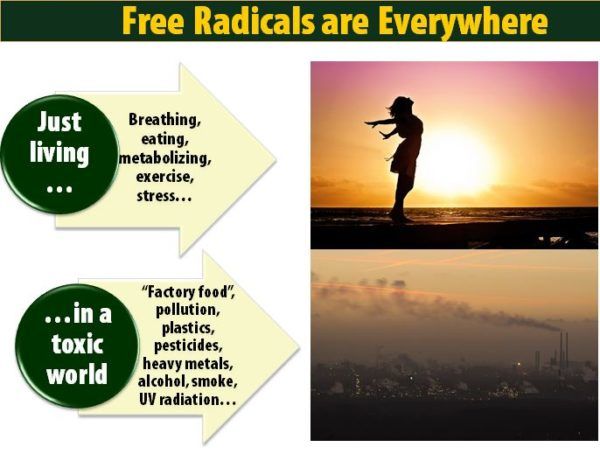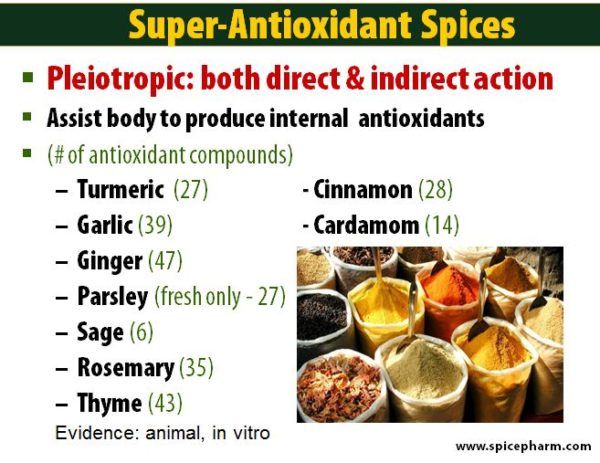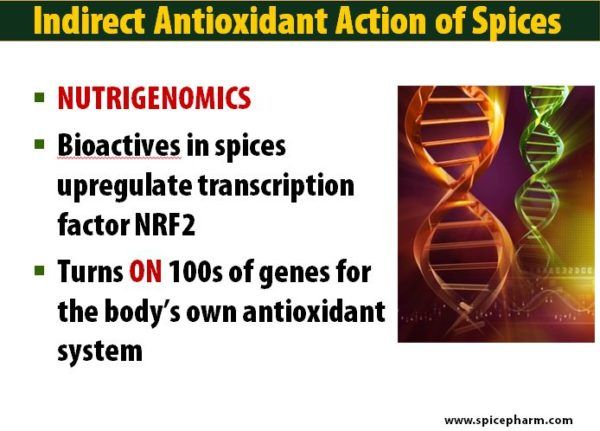Free Radicals Declare War Against Your Body But Spices Fight Back
Free Radical Damage: A Fast Track Ticket to Aging
Free radical damage is the evil twin of chronic inflammation: where you have one, you have the other.
If you feel tired and toxic, free radicals could be the culprit. In fact, free radical damage is something I call a “Fast Track Ticket to Aging” as it accelerates the aging process in your body.

The Gang of Roving Thug Molecules
You’ve probably heard of free radicals − those unstable thug molecules that lack an electron. They wreak havoc on your cells and cell membranes by stealing electrons that line the surface of your cells.
Just one free radical can damage millions of other molecules by removing those electrons if the chain reaction is left unchecked.
Free radicals are everywhere in our toxic world:
- vehicle exhaust
- pollution
- smoke
- processed food
- artificial colors
- preservatives
- cooking methods
- additives of all kinds
- rancid and heat-damaged cooking oils (especially so-called healthy polyunsaturated vegetable oils!)
- pesticides
- chlorinated water
- swimming pools
- cleaning products
- personal care products
- plastics
- industrial chemicals
- and on and on…
Free radicals − particularly those from chemical pollution, factory food, X-rays, and UV light − are often mutagens. Yes, capable of mutating your cells. While this may sound cool in sci-fi movies and cyberpunk novels, it’s not really great in your body.
These can have cumulative effects as you age, leading to degeneration of your cardiovascular, neurological, and metabolic systems, as well as your skin and other rather valuable organs.
Rusting Away from the Inside…A Cruel Joke of Mother Nature?
Your own body creates free radicals as you breathe, digest food, and interact with UV sunlight and other radiation. Free radicals are even there when you are flying in an airplane!
Some people consider this a cruel joke of Mother Nature: you need food and air to live, but as your cells break down nutrients and oxygen, they create free radicals that flood your body, eat away at cell membranes and damage tissues and organs.
This internal rusting, known as oxidative stress, is linked to everything from wrinkles to dementia to clogged arteries, and ultimately to why you age and how you die.

I don’t really think of it as a cruel joke, but as Nature’s way of bumping us off to make way for the next generations to reproduce and prosper. We simply rust away.
Apple founder Steve Jobs put it another way in a commencement address at Stanford University in June 2005. He said:
“Death is very likely the single best invention of life. It is life’s change agent. It clears out the old to make way for the new. Right now the new is you, but someday not too long from now, you will gradually become the old and be cleared away.”
But before you’re cleared away, while life is pulsing inside you, it’s good to pay attention to what’s driving your vitality at a cellular level: mitochondria.
Free Radical Troops Charge Toward the Mitochondria
Mitochondria are the little engines inside each of your cells that create the energy that keeps you humming along. Mitochondria never sleep. They continuously deliver the chemical energy that powers every cellular process, and are the very cellular core of your vitality and energy. Their gradual, or rapid, demise is a key factor in your rate of aging.
Energy intensive cells such as those in your heart may have 2,000 mitochondria per cell, while cells in your skin may have 200. Even in the best of worlds, our mitochondria decline as we age. By the time you’re 70 years old, you may only have half that number – if you’re lucky!
Mitochondria use over 90% of the oxygen we breathe in the process of burning fuel to power your life. As they are dead center in the fuel burning process, they are highly susceptible to free radical damage. Like car engines, our cellular engines produce less energy and belch more exhaust as they get old and wear out.
This creates more free radicals. On top of it, sugar and processed foods are like dirty gas. Garbage in, garbage out!
Your mitochondria need constant antioxidant protection. When they are not working properly, you suffer: low energy, fatigue, slow metabolism, weight gain, memory loss, pain and more. As they slow down, you slow down. In other words, you’re on the fast track to aging!
The How and WOW of Spices as Antioxidants
You’ve probably heard about the importance of antioxidants to squelch free radicals. But here’s something a lot of people don’t know: there are two categories of antioxidants, direct and indirect.
Direct Antioxidants
These are the most commonly understood. These are things like Vitamin C, Vitamin E and beta-carotene that directly give up an electron which prevents that free radical from taking an electron from your cells. They zap a free radical, and then they are depleted.
While these nutrients are important, it’s best to avoid mega-dose supplements of single “direct” antioxidants, like C, E or beta-carotene. In excess, they can backfire and promote more free radicals. It’s better to get a wide variety from a good diet of unprocessed foods backed up with a good multivitamin supplement.
To best protect your mitochondria and DNA, you need the antioxidants that your own body produces.
Indirect Antioxidants
When you’re young and healthy, your body churns out lots of its own antioxidants to mop up free radicals. Like a new car, you have a remarkable array of catalytic converters to clean up the byproducts of burning fuel. But as you get older, your maintenance systems become weaker and start to falter.
These are three of the major “catalytic converter” antioxidants and enzymes your body makes. They protect your mitochondria and DNA and scavenge millions of free radicals per second, rather than on a 1:1 basis:
- Glutathione
- Superoxide Dismutase
- Catalase
Indirect antioxidants are substances that fuel your body in producing these antioxidants. And spices are chock full of these supportive compounds. Now that’s a WOW!

Some Spicy Goodness
Dr. Bruce Ames, biochemist and anti-aging guru at UC Berkeley gives some sage advice on this. He says:
“It’s better to turn on your body’s defenses than just take antioxidants.”
Below are some excellent spices to help you do just that, along with the number of known antioxidant compounds in each one [i]:
They have pleiotropic action − both direct AND indirect. As different antioxidants work on different kinds of free radicals, and considering what we’re bombarded with every day, you want a good variety to beat back all the toxic thugs! Plus, they have synergistic affects when taken together. So spice it up!

Spice Up Your Genes
And here’s further WOW on the antioxidant power of spices. The latest studies in a field called nutrigenomics are getting down, and I mean really down deep into the details of how this works.
Bioactive compounds in a number of spices activate a transcription factor called NRF2, which is a master switch inside cells. NRF2 then turns on protective genes which then activate your body’s antioxidants and detox enzymes.
Researchers at the Cancer Prevention Center of Rutgers University confirm this, saying:
“Dietary phytochemicals derived from various vegetables, fruits, spices, and herbal medicines induce Nrf2-mediated antioxidant/detoxifying enzymes, restore aberrant epigenetic alterations, and eliminate cancer stem cells (CSCs). The Nrf2-mediated antioxidant response prevents many age-related diseases, including cancer.”[ii]
What this means is that the molecules that make up the veggies and spices we eat or drink are going to activate that master switch that tells our body to produce antioxidants! Talk about upstream effects.

1, 2, 3 Adding Spice To Set You Free
When adding in our spicy friends, there are many things to consider. We can enhance so many aspects of our body and I will give you a few ways to do this in the next few sections. The first of these is…
Adding Glutathione
Dr. David Jockers, a Maximized Living doctor who runs the Exodus Health Center in Kennesaw, Georgia lists best foods for naturally boosting your glutathione. Start with vitamin D (boost it naturally with 20-60 minutes of sunlight every day or supplement with an emulsified Vitamin D3 supplement) for optimal glutathione production.
Plus add glutathione precursors in your diet. Your body uses these amino acids as building blocks to create glutathione: glycine, glutamic acid and cysteine.
The best food sources of these amino acids are high quality, non-denatured animal products. These include non-denatured grass-fed whey protein and cultured, raw grass-fed dairy products and raw, organic eggs. He notes that cultured, raw grass-fed dairy products are incredibly good sources of highly bioavailable amino acids and offer more cysteine than any other food source. While vegetables are much lower in these critical amino acids, the best sources include avocados, onions, spinach, asparagus and mushrooms.
Stabilize Your Mitochondria
Mitochondrial stability can be enhanced through heavy consumption of whole-food antioxidants and the right amount of trace minerals. Make generous use of the following in meals, soups, salads, and drinks:
- fresh lemon juice
- fresh lime juice
- pink salts
- turmeric
- rosemary
- ginger
- oregano
- cinnamon
- cloves
- thyme
- sage
- parsley
- cilantro
To round out his mitochondrial boosting strategy, Dr. Jockers advises a daily raw, whole-food multi-vitamin that supplies ample amounts of folic acid, B6, B12, Zinc, trace minerals, & CoQ10.[iii], [iv]
Bring on the Super B’s!
For further protection for your mitochondria and DNA, bring on the B’s! Particularly Vitamins B2 and B3 — get a 2 for 1 special! Some of the best sources of BOTH Vitamin B2 and B3 are: mushrooms, spinach, summer squash, asparagus, Swiss chard, mustard greens, collard greens, broccoli, turnip greens, venison, green beans, bell peppers, kale, cauliflower, Brussels sprouts, winter squash, green peas, carrots.
Other good sources of B2 include: romaine lettuce, celery, tempeh, almonds, yogurt, and eggs.
Additional sources of B3 include: tuna, chicken, turkey, halibut, beef, lamb, tomatoes, salmon, eggplant, shrimp, sardines, cod, cantaloupe, peanuts, fennel, spelt, corn, sweet potato.
Pair any of these B-rich foods in recipes boldly flavored with spices to keep your mitochondrial engines running smoothly.
Keep In Mind…Eat a Rainbow
Certain colorful combinations of spices and fruits and vegetables have particularly synergetic antioxidants that exert anti-aging effects. Phytonutrients with notable synergies with the compounds in spices include:
- Sulforaphane, found in broccoli and broccoli sprouts, Brussels sprouts, and other cruciferous vegetables
- Blue-purple anthocyanins in blueberries, raspberries, cherries, cranberries, eggplant peel and red cabbage, and the herbs milk thistle and ashwagandha
In fact, these food and spice pairings in each section will help begin your fast track to spicy vitality!
Just remember the words of Dr. Joseph Mercola, MD:
“Due to their nutrient-dense status, spices and herbs promote your overall well-being with antioxidants more potent than many fruits and veggies. They promote health and well-being in your entire body, not just in a particular area. This ‘whole person’ approach is why I believe these spices and herbs can benefit you so greatly.”
Footnotes:
[i] Dr. Duke’s Phytochemical and Ethnobotanical Databases http://www.ars-grin.gov/duke/
[ii] Lee JH, Shu L, Fuentes F, Su ZY, Kong ANT. Cancer Chemoprevention by Traditional Chinese Herbal Medicine and Dietary Phytochemicals: Targeting Nrf2-Mediated Oxidative Stress/Anti-Inflammatory Responses, Epigenetics, and Cancer Stem Cells. J Tradit Complement Med [serial online] 2013;3:69-79. www.jtcm.org/text.asp?2013/3/1/69/107700
[iii] http://www.drjockers.com/2012/07/boost-glutathione-levels-naturally/
[iv] http://www.naturalnews.com/031997_mitochondria_support.html
